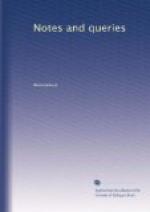Herstmonceux Castle (Vol. ii., p. 477.).—The elucidation of your correspondent’s second Query suggests several further questions; for instance—Was Juliana wife of William, the owner of the estate? If so, did she die in the lifetime of her husband? If so, did she leave issue? semble not, and assuming her to have no direct heirs, the estate would escheat. Was the King lord of the fee? Were William de Warburton and Ingelram de Monceaux relatives of the half blood of Juliana? If so, a re-grant to them, if claimants, would not, I imagine, have been unusual upon payment of a fine to the crown. It would almost seems as if a doubt existed as to the heirship, from the expression “whose next of kin they SAY_ they are_.” This note is conjectural only, and is therefore offered with much diffidence.
I.B.C.
Suem.—Ferling.—Grasson (Vol. iii., p. 7.).—It is obvious that your correspondent’s extract from the Rotherfield court-roll is not accurately transcribed. The original most probably contains no such words as suem.
Ferling is a well-known word in old legal phraseology. As a term of superficial measure it denotes a quarter of an acre; of lineal measure, an eighth of a mile, or furlong.
Grassum is the term commonly used in the northern parts of the kingdom to signify the fine, or foregift in money, paid by a lessee for the renewal of his lease from a lay or ecclesiastical corporation. It is derived from the A.-S. Gaersum or Gaersame, a treasure; the root of which is still retained in the northern word Gear, goods or stuff.
[Delta].
Jan. 10. 1851.
Portrait of Archbishop Williams (Vol. iii., p. 8.).—Your correspondent Y.Y. desires to be informed of the “locus” of the portraits of several bishops, among them of John Williams, Archbishop of York. There is a full-length in the hall of this college, which I shall have great pleasure in showing to him should he ever find it convenient to pay Cambridge a visit.
P.J.F. GANTILLON.
St. John’s College.
Swans hatched during Thunder (Vol. ii., p. 510.).—Some years ago I purchased a pair of swans, and, during the first breeding season after I procured them, they made a nest in which they deposited seven eggs. After they had been sitting about six weeks, I observed to my servant, who had charge of them and the other water-fowl, that it was about the time for the swans to hatch. He immediately said, that it was no use expecting it till there had been a rattling peal of thunder to crack the egg-shells, as they were so hard and thick that it was impossible for the cygnets to break them without some such assistance. Perhaps this is the reason why swans are said to be hatched during a thunder-storm. I need only say, that this is a popular fallacy, as swans regularly hatch after sitting six weeks, whether there happens to be a thunder-storm or not.




